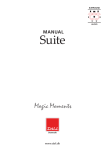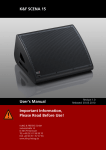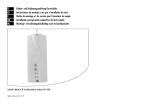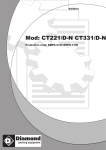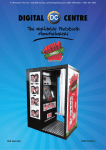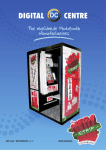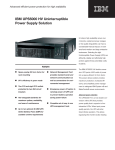Download DALI Loudspeakers Euphonia Series User's Manual
Transcript
EUPHONIA Manual EUPHONIA Series www.dali.dk anish The black boxes udiophile oudspeaker contain headwords for the DALI ® is renowned among music lovers throughout the world for its subjects discus- unique speakers and cables, all constructed and build for uncompro- sed on each mising design and sound requirements. Our ultra-modern factory in page. Denmark is fully equipped with facilities for development and production of quality speakers. The aim of this manual is to DALI's principal competence is development and optimisation of known ensure that you and new technology in the field of audio and acoustics. The result is con- have the infor- tinuous development and optimisation of new and existing models. mation you need for setting We always keep our goal firmly in view for each and every DALI ® speaker: up, connecting To recreate sound experiences in your home that will carry you away, and positioning making you forget time and place... your Euphonia speakers. It is important to us that your new DALI ® speakers be set up and connected optimally. This manual contains our recommendations for setup, connection and maintenance. Enjoy! 2 ndustries Unpacking Unpacking After unpacking and setting up the equipment in the most suitable way, the enclosed spikes should be mounted ( MS5, MS4 and AS2). The thread bushings are embedded in the base. After mounting, tighten the lock nuts to ensure the best possible mechanical stability. DALI ® recommends the use of spikes for floor-standing speakers to ensure the Euphonia best possible acoustic connection between floor and speaker. Running-in Running-in Like any other mechanical system, a speaker needs to be "run in", so you can look forward to a gradual improvement in sound quality over the initial period. Unlike other mechanical systems, regular use will in fact extend your loudspeakers lifetime. 3 D How the room How the room affects the sound affects the sound 24,0 Some of the sound you hear does not come directly from the actual speakers but are reflections from floor, ceiling and walls. These reflections can be dampened by objects such as furniture, plants and carpets. If the sound is bright, adding soft items such as curtains and carpets can help. If the room has large window panes, drawing the curtains will prevent reflections from the glass surfaces. As a general guide, avoid large, hard reflective surfaces immediately around the speakers, as these will act like an eccho effect and weaken the spatial perspective of the sound image. Try placing a tapestry behind the speakers, laying a rug in front or placing a large plant at the side - it's 12,0 4,0°° 549 0 549,0 Both the amount and quality of the deep bass depend on the size and shape of the room, and the position of the speakers. If positioned near a side or back wall, this will accentuate the bass. A corner location will accentuate it even more, but will also increase the reflections. The decision is yours, so experiment with different positions to find which provides the ideal sound for you. 21,6 81,2 461,1 Every room has its own distinctive acoustics, which influence the way we experience the sound from a speaker. In actual fact, it's a matter of how the room accommodates the sound and then dampens it. You can influence the acoustics of your listening room in various ways. When you are satisfied with the location of the speaker, it is important to ensure that the speaker does not tilt or is unstable in any other way. For the floor-standing models, it is very important that they are mounted with the enclosed spikes. The rear speaker, RS3, must be hung carefully using the enclosed fitting, which should be mounted with materials suitable for the wall. 6 12,4 D 20,0 12 0 surprising how much this can affect the precision of the sound image. Connection Connection & Cables The connection to your amplifier is extremely important for your sound experience. Before you connect cables or make any changes to the connections, you must disconnect your amplifier from AC-power. Always use the same type and length of cable for the left and right speakers. This class of speaker should be connected with very high quality cables such as DALI ® Wave or Wasatch. Using inferior cables is like putting low cost tyres on a fullblooded sports car. As an alternative to direct installation in the terminal screws, the cables can also be connected to the terminals with special plugs such as DALI ® connect to ensure a stable connection and loss-free transfer of the signal. A detail often overlooked is connection to the correct polarity, i.e. the red terminal (+) on the amplifier must be connected to the red terminal (+) on the speaker, and the black terminal (-) on the amplifier must be connected to the black terminal (-) on the speaker. DALI ® recommends connection with DALI ® connect plugs or spade plugs to ensure a perfect electrical connection and mechanical stability. In the following pages, we will describe the special conditions that occur when connecting with tri-wiring or bi-wiring, and connecting the AS2 subwoofer. 7 Tri-wiring Bi-wiring Tri-wiring / Bi-wiring Tri-wiring means that the bass, midrange and treble tone ranges are each fed through their own separate speaker cable. In the ultimate set-up, there is an amplifier to handle each range (tri-amping). Tri-amping is the sophisticated consequence of multi-wiring in a multipath speaker, which allows the maximum benefit of the EUPHONIA MS5. All other EUPHONIA models are connected by bi-wiring. Bi-wiring or bi-amping improves the acoustic quality markedly and can be highly recommended. Bi-wiring provides greater openness in the acoustic image and reduces distortion. Bi-amping - when separate amplifiers are used for the bass/midrange tone and treble ranges - provides even greater openness in the acoustic image and adds increased dynamics. For bi-wiring on the MS5, we recommend that the treble and midrange terminals are combined and the bass terminals are supplied separately. DALI ® EUPHONIA speakers can, of course, be used with single-wiring. In this case, the enclosed cables should be used with three stripped parts that are fed down through the terminals, thus connecting the bass, midrange and tweeter terminals. DALI ® recommends that EUPHONIA speakers are connected with bi-wiring as a minimum to ensure the best possible conditions for acoustic imaging. Treble Midrange Bass We recommend DALI ® Silver Wave Four speaker cables for bi-wiring. For tri-wiring, we recommend DALI ® Silver Wave Four for the treble and midrange tone range, and DALI ® Silver Wave for the bass. This keeps powerful currents from the bass sig- 8 nals away from the cables that carry the treble/midrange tone signals. Connecting the AS2 subwoofer Connecting EUPHONIA Thanks to its active crossover network and numerous connection options, the AS2 AS2 provides further advantages such as stepless variable phase. The AS2 is connected to a line signal either via 'Left/Right Input', 'Mono Input' or 'LFE Input'. It is important that the level of the connected line signal is controlled together with the equipment’s volume control. Connection to stereo signal with full frequency content If the subwoofer is connected to a pre-amplifier without a built-in crossover network of the same high quality as the AS2, we recommend that the subwoofer’s 'Left/Right Inputs' are connected to a signal with full frequency content from a Stereo signal with full frequency content normal pre-amplifier output. The subwoofer’s built-in crossover network takes care of the necessary filtering. Once the subwoofer’s 'Left/Right Inputs' are connected to a stereo signal with full frequency content, there is access to a highpass filtered signal (without the deep tones) on the 'Left/Right Output' sockets. This signal is connected to the power amplifier for the main speakers, which thus does not need to handle the demanding deep tones. This will always result in the main speakers playing more cleanly and un-stressed. 9 10 Output terminals Functions The output terminals (Left & Right) provide a filtered output signal with a crosso- EUPHONIA ver frequency of 70 Hz and cut off with a 2nd order high-pass filter. This set of ter- AS2 minals can be used if the subwoofer is used together with the speaker driven by a separate amplifier, if you want only the frequency range over 70 Hz to be handled here, e.g. to protect the speaker system against very low frequency content - low frequencies which the AS 2 has been selected to deal with. Other functions The 'Power' button is the main switch for the system. You should switch off the system completely when it will not be in use for long periods. When making or changing connections, you must always switch off the system completely. The 'Auto Shut Off' function places the AS2 in stand-by mode after 15 minutes without a signal on the input. When the AS2 receives a signal again, the system comes on automatically. Overloading If you often play very loud, you should be careful of any dissonance or distortions. The AS2 is protected against short-term overloading, but if you oftentend to overdrive the system, you should use a permanently lower setting on the volume level control on the AS2. Repeat any phase adjustment to improve the connection between the front speaker and subwoofer. It may be this fine adjustment which provides the desired deep bass level. 11 Adjustement Adjustment of the AS2 subwoofer EUPHONIA AS2 Begin by setting the 'Level' and 'Low-pass Crossover Frequency' to the middle position (’12 o’clock’). Turn the 'Phase' control in the '0' position, and then set 'Power' to the 'ON' position. If the subwoofer is connected via the LFE Input, both the 'Level' and 'Low-Pass Crossover Frequency' controls will not be functioning, and should be set to the minimum position. However, adjustment to the correct level and crossover frequency is still of great importance, and these adjustments must be made when setting up the connected equipment. Please refer to the manuals of the connected equipment. We recommend the use of the procedure below to achieve the best results. Use a piece of music you know well and preferably containing rhythmic base tones such as bass drum, electric bass or similar. Level Level Adjust the volume on the AS2 - or on the connected equipment when using the LFE input - so that the low frequency level match the level from the front speakers. You must make adjustments so that you can notice the contribution to the sound from the AS2 - but without the bass becoming too dominant. The bass must act steadily and precisely. If you set the volume too high, you risk over-modulating the subwoofer, which will adversely affect the all-important reproduction of the midrange tones from the front speakers. Using the same setting for both sur12 round and 2-channel stereo is not always optimal. So it is useful to make a note of your preferred settings for each type. Maintenance Maintenance Clean the cabinets with a soft, dry cloth. If the cabinets are dirty, wipe with a soft cloth dipped in all-purpose cleaner and then well wrung out. Be very careful if wiping the speaker membranes, as they are very fragile. Fabric frameworks can be vacuumed and wiped with a well-wrung, lint-free cloth and mild all-purpose cleaner. Quality in all aspects DALI ® - quality in all aspects The Euphonia series has been developed and produced without compromise of any kind. To achieve the optimum sound from your Euphonia speakers it is important that all links in your stereo/surround system are premium selection. We therefore repeat our suggestion that you use cables of very high quality throughout the equipment - preferably DALI ® Wave cables, which fully meet the standards of Euphonia speakers. We wish to congratulate you once again on your investment, and to inform you that your authorised Euphonia agent will be happy to provide you with advice on both connection and adjustment of your stereo/surround equipment. Finally we would like to invite you to visit our website - www.dali.dk - where you can read more about the Euphonia range, including the implemented technology behind 14 the series, other aspects of quality and the stunning story of DALI ®. Technical specifications Technical specifications MS 5 MS 4 CS 4 RS 3 AS 2 Active Subwoofer Main Speaker Main Speaker Centre Speaker Rear Speaker 31 - 28.000 Hz 33 - 28.000 Hz 45 - 28.000 Hz 64 - 28.000 Hz 25 - 200 Hz Cross over frequencys 685/3.300 Hz(17.000) 3.000 Hz(17.000) 2.400 Hz(17.000) 2.600 Hz(17.000) 40 - 100 Hz Sensitivity(2.83 V/1m) 89 dB 88 dB 88.5 dB 87 dB - Nominial impedance 4.0 Ω 4.0 Ω 4.0 Ω 4.0 Ω 22 kΩ Minimum impedance 3.3 Ω 3.6 Ω 3.4 Ω 4.2 Ω 22 kΩ 120 dB Frequency range +/- 3dB Maximum SPL Rec. amp. power (8 ohm) Amplifier High frequency drivers 115 dB 111 dB 111 dB 108 dB 50 - 500 Watt 50 - 350 Watt 50 - 350 Watt 50 - 250 Watt - - 650 W RMS/ 1.300 W peak 1 x 29 mm soft dome 1 x 29 mm soft dome 1 x 29 mm soft dome 1 x 29 mm soft dome 1 x 10 x 55 mm Ribbon 1 x 10 x 55 mm Ribbon 1 x 10 x 55 mm Ribbon 1 x 10 x 55 mm Ribbon Midrange drivers Low frequency drivers Bass reflex system resonance Dimensions (HxWxD) - 1 x 61⁄2" - - - - 2 x 8" 2 x 61⁄2" 2 x 61⁄2" 1 x 61⁄2" 2 x 12" long throw 24.0 Hz 31.5 Hz 30.0 Hz 72.5 Hz (sealed) - 124.5x28x55.2 cm 101.8x21.9x42.3 cm 23.9x67.3x51.7 cm 47x20x20.3 cm 40.5x57.3x61.3 cm 49.5x11.25x22.0 inch. 40.75x8.75x17.0 inch. Weight 60 kg/132 lb 35 kg/77 lb 9.5x27.0x20.75 inch. 20 kg/44 lb 259 4 18.75x8.0x8.0 inch. 16.25x23.0x25.50 inch. 10 kg/22 lb 55 kg/121 lb 15 E 16 SAFETY The exclamation point within an equilateral triangle is intended to alert you to the presence of important operating and maintenance (servicing) instructions in the literature accompanying the appliance. CAUTION 16. Servicing - The user should not attempt to service the appliance beyond that described in the operating instructions. All other servicing should be referred to qualified service personnel. 15. Damage Requiring Service - The appliance should be serviced by qualified personnel when: a. The power-supply cord or the plug has been damaged; or b. Objects have fallen, or liquid has been spilled into the appliance; or c. The appliance has been exposed to rain; or d. The appliance does not appear to operate normally, or exhibits a marked change in performance; or e. The appliance has been dropped, or the enclosure damaged. 14. Object and Liguid Entry - Care should be taken so that objects do not fall and liquids are not spilled into the enclosure through openings. 13. Non-use Periods - The power cord of the appliance should be unplugged from the outlet when left unused for a long period of time. 12. Cleaning - Do not use any liquid cleaners. Use only a dry cloth to wipe off dust and grease. 11. Power Cord Protection - Power-supply cords should be routed so that they are not likely to be walked on or pinched by items placed on or against them, paying particular attention to cords at plugs, convenience receptacles and the point where they exit from appliance. 10. Power Sources - The appliance should be connected to a power supply only of the type described in the operating instructions or as marked on the appliance. 9. Heat - The appliance should be situated away from heat sources such as radiators, heat registers, stoves, or other appliances that produce heat. 8. Ventilation - The appliance should be situated so that its location or position does not interfere with proper ventilation. For example, the appliance should not be situated on a bed, sofa, rug, or similar surface that may block the ventilation openings; or placed in a built-in installation, such as a bookcase or cabinet, that mayimpede the flow of air through the ventilation openings. 7. Wall or Ceiling Mounting - The appliance should be mounted to a wall or ceiling only as recommended by the manufacturer. 6. Carts and Stands - The appliance should be used only with a cart or stand if recommended by the manufacturer. 5. Water and Moisture - The appliance should not be used near water - for example, near a bathtub, washbowl, kitchen sink, laundry tub, in a wet basement, or near a swimming pool and the like. 4. Follow Instructions - All operating and use instructions should be followed. 3. Heed Warnings - All warnings on the appliance and in the operating instructions should be adhered to. 2. Retain Instructions - The safety and operating instructions should be retained for future reference. 1. Read Instructions - All the safety and operating instructions should be read before the appliance is operated. The lightning flash within an equilateral triangle is intended to alert you to the presence of uninsulated „dangerous voltage“ within the product’s enclosure that may be of sufficient magnitude to constitute an electric shock to persons. CAUTION: TO REDUCE THE RISK OF ELRCTRIC SHOCK, DO NOT REMOVE THE BACK PANEL. NO USER-SERVICEABLE PARTS INSIDE. REFER SERVICING TO QUALIFIED PERSONNEL. Concept Interest RISK OF ELECTRIC SHOCK DO NOT OPEN

















